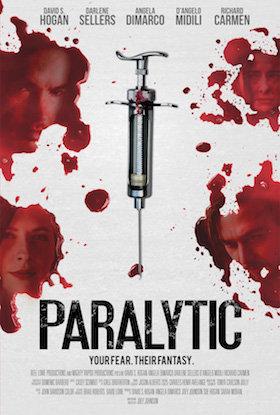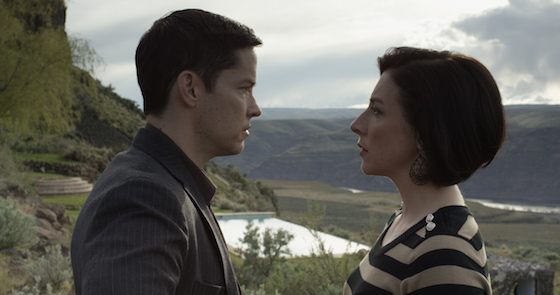[Rock Fist Way Down]
Holy God…where does one even start with Paralytic? This is a movie so bad that it should come with a Surgeon General’s warning advising people of the very real possibility that it could actually make someone dumber. This is a picture that forgoes plot development and traditional storytelling techniques in favor of putting its leads on the phone, just explaining the story to each other and the audience. This is a film with acting so torturously shitty that the furniture in the scenes outperforms the humans in most cases. Hell, at one point, Paralytic even flirts with the so-bad-it’s-good distinction, yet finds a way to spoil even this.
Paralytic starts with title cards explaining that an up and coming Mexican cartel, Chutro, has emerged in recent years to challenge the established players in the region. This text goes on to tell the audience that the Chutro cartel has brought cops, lawmakers, and politicians all to heel with their unrelenting ferocity and brutality. The film then opens in a Los Angeles bar, where a hitter for the Chutro cartel has a run-in with his handler. The handler is trying to kill the hitman because the latter gentleman refused a job, which by itself does not seem to be grounds enough for rolling the dice and trying to kill a professional assassin, yet this is the set-up for everything to follow.
The hitman from this opening scene, Carson (David S. Hogan), flees L.A. after the failed attempt on his life and holes up in a remote cabin in Washington State, where writer/director Joey Johnson jumps ahead in his timeline to introduce another character and plot-thread. On the surface, this time-jump is somewhat necessary, for the conceit of Paralytic revolves around a small town sheriff’s deputy unspooling the events that brought Carson to her neck of the woods. This deputy, Alice (Darlene Sellers), is dealing with the fallout related to Carson’s drama, and is set up as the key to making sure the bad guys in Carson’s world get their comeuppance. Not content with just two timelines, Johnson delves into Carson’s background by giving him his own flashback narrative, which only further muddles a plot that could have unfolded traditionally in the span of twenty minutes.
Thus, Paralytic is actually three different stories jumbled together to tell just one (not especially original) tale. Because the overarching revenge story of Paralytic doesn’t carry a whole lot of weight, most of the film’s run-time is devoted to fleshing out the character and narrative components that were skipped to start this thing in media res. The three competing timelines vie for the audience’s attention, and are only loosely held together via a never-ending stream of phone conversations that just talk through the plot. Mr. Johnson seems unable to convey his story without having his characters literally TELL the thing, bulletin point style, so these phone conversations take up most of the picture and are a torturous exercise in naked exposition.
In these moments, it is hard to tell if the acting is really as bad as it seems to be, or if the dialogue that tumbles out of their mouths is so poorly conceived and constructed that five Oscars worth of talent couldn’t salvage it. It’s a tough call, but the work of the featured leads indicates that it was indeed a fault shared equally between the script and actors. Carson as played by Mr. Hogan only has one speed: squinty-eyed intensity, and Darlene Sellers plays her deputy character like a high schooler flustered during finals week. Again, the script doesn’t help them in the slightest, but as acting goes, it gets so bad at times that it is distracting.
As characters, Carson and Alice don’t really have any color or definition. What little the audience learns about them comes in half-assed snippets that flirt with something resembling depth, but never quite gets there. Early in the film, Alice is seen sipping from a flask while still in uniform, and has a backstory that allows for some conflict outside the bounds of the main story, yet neither component drives her thread forward in any way that has an effect on events. Is she a drunk? Does she have a valid conflict at home tied into an upcoming career change? Maybe…but neither development informs her choices in any real way, and doesn’t allow the audience any insight into the person she is outside of her role in the narrative. In other words, the story was going to move ahead whether it was Alice in the driver’s seat, or a cross-dressing werewolf: it really doesn’t matter.
Things are worse for Carson, who spends his flashback time falling in love with a co-worker for no other reason than because they are both there, and the story’s end-game demands it. The audience has no idea at the start of Paralytic who Carson is save for an assassin, and all the time spent with him in his flashback does nothing to give anyone a reason to care about him. Even more baffling is his co-worker’s attraction to him, for except for the fact that he really likes beer, and is allegedly good at his job, she and the audience learn nothing about him.
Currently playing at this year’s Seattle International Film Festival, Paralytic is so soul-crushingly bad that it actually makes other movies seem better by comparison, so if nothing else, it might be worth a watch just as a palate cleanser. But then a person would have to suffer through a humorless, mean-spirited picture drowning in bad acting, dreadful writing, and lethargic pacing that would try the patience of Job. Buyer beware.








Comments on this entry are closed.